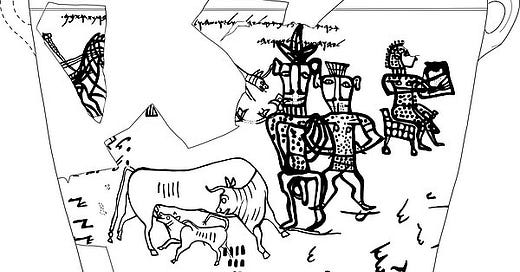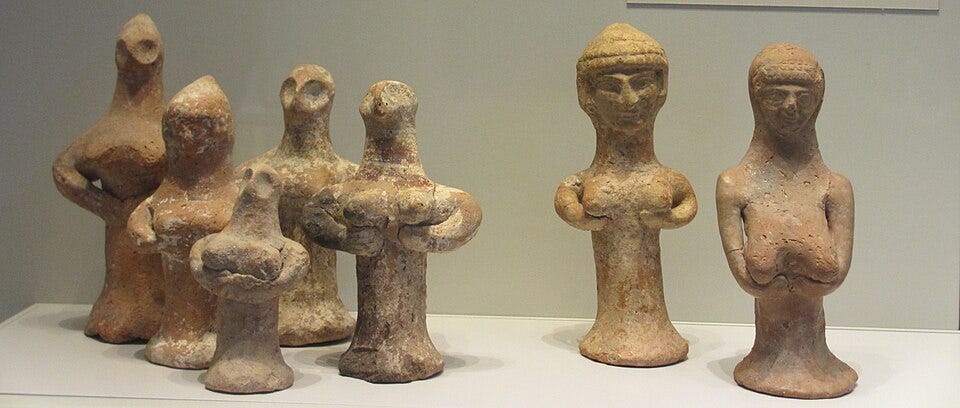What if I told you the God of the Bible once had a goddess by his side?
Let's see what scholars have to say about it.
You’re reading a free post from Reasoned Reality, where I dissect religious dogma and challenge faith-based narratives with facts, reason, and a sharp edge.
If you value this work and want to help it grow, please consider becoming a paid subscriber for just $6.66/month. Your support helps fund future deep-dive essays, video documentaries, and public challenges to Christian nationalism.
Truth doesn’t fear scrutiny. It invites it.
What if everything you’ve been told about the one true God left out the part where He had a wife?
I’m not talking fringe conspiracy or wild reinterpretation. I’m talking about what scholars, archaeologists, and ancient inscriptions agree on: For centuries, Yahweh had a divine partner. Her name was Asherah.
That’s not poetic. That’s historical.
The Forgotten Goddess
In ancient Canaanite religion—the cultural soil from which Israelite religion emerged—Asherah was the consort of El, the chief god. She was a mother goddess. A powerful symbol of fertility and protection.
And in early Israel, she didn’t vanish. She evolved.
Early Israelites, especially in the northern kingdom, worshiped Yahweh alongside Asherah. Not metaphorically. Literally. This is not speculation—it’s carved into stone.
The Hard Evidence
Two inscriptions from the 8th century BCE are the smoking gun:
Kuntillet Ajrud: An inscription on a storage jar reads, “I bless you by Yahweh of Samaria and his Asherah.”
🏺 Kuntillet Ajrud Inscription
Image: Photograph of a painted jar from Kuntillet Ajrud, featuring the inscription "Yahweh and his Asherah."
Source: Wikimedia Commons
License: Public Domain
Khirbet el-Qom: Another inscription appeals for a blessing “by Yahweh and his Asherah.”
Not just Yahweh. Yahweh and his goddess.
But it doesn’t stop with inscriptions. Archaeologists have uncovered thousands of female figurines in Israelite homes—clay statues of women with pronounced breasts. These are called Judean Pillar Figurines and are overwhelmingly interpreted as representations of Asherah. They weren’t rare. They were common. As in, one or more in almost every house.
🗿 Judean Pillar Figurines
Image: Photograph of Judean pillar figurines from the Israel Museum, Jerusalem.
Source: Wikimedia Commons
License: Creative Commons Attribution-Share Alike 3.0 Unported
Let that sink in: early Israelite families had physical representations of a goddess. Yahweh didn’t rule alone.
Even the Bible—reluctantly—acknowledges her. It repeatedly references Asherah, usually in the context of being destroyed. Shrines torn down. Poles broken. Images burned. Why? Because she was there.
Asherah worship wasn’t an outsider threat—it was in the temple, in the home, and at the heart of the faith before it was rewritten.
When Yahweh Went Solo
So what happened?
Politics.
In the 7th century BCE, King Josiah launched a full-scale religious reform, detailed in 2 Kings 23. He centralized worship in Jerusalem and declared Yahweh the one and only God. Temples were smashed. Sacred trees were uprooted. Asherah’s image—once housed inside Yahweh’s temple—was removed and burned.
This wasn’t just a theological shift. It was a political campaign to consolidate power. And the scribes who later compiled the Hebrew Bible? They were on board.
Most of the Hebrew Bible was written or redacted during or after this period. That means the stories, laws, and portrayals of God we read today were shaped after monotheism was already enforced.
The final product? A God who has always been alone. Always sovereign. Always unchanging.
But that’s the curated version.
Here’s the Knowledge Bomb
Monotheism wasn’t the original belief of the Israelites.
Yahweh wasn’t always alone.
He had a partner. Her name was Asherah.
And she wasn’t removed because people stopped believing in her. She was erased—by kings, by priests, by redactors with an agenda.
This isn’t speculation. This is scholarly consensus. When you follow the archaeology, the inscriptions, and the editorial history of the Bible, the pattern is clear:
The God of the Bible didn’t start as a lone deity. He became one.
Timeline: Yahweh and Asherah
1200–1000 BCE: Israelites emerge in Canaan. Asherah is already a major goddess in the region.
900–800 BCE: Inscriptions and artifacts show Yahweh and Asherah being worshiped together.
700s BCE: Figurines of Asherah flood Judah. She’s part of home life and temple practice.
622 BCE: Josiah’s reforms. Asherah is purged. Worship of Yahweh is centralized.
586 BCE: Babylon destroys Jerusalem. After the Exile, monotheism is entrenched.
500–400 BCE: Hebrew Bible is finalized—now reflecting a God who’s always been singular.
What This Means
If the idea of God having a goddess partner sounds ridiculous, it’s because you were handed the edited version.
The Hebrew Bible is the product of theological redaction and political necessity. The version that survived is the one that erased Asherah.
But the stones still speak. The figurines still exist. And the inscriptions still say what they say.
This isn’t a threat to faith. It’s a reminder: religion evolves. Scripture is curated. And sometimes, what gets left out tells you more than what gets left in.
The God of the Bible had a goddess by his side. Until he didn’t.
If you found this valuable, please consider becoming a paid subscriber.
This project is sustained by a small number of supporters who believe in challenging religious narratives with honesty, logic, and bold storytelling.
Your support fuels everything I do—and it keeps these ideas reaching the people who need them.
👉 $6.66/month. Because truth doesn’t fear scrutiny. It invites it.





